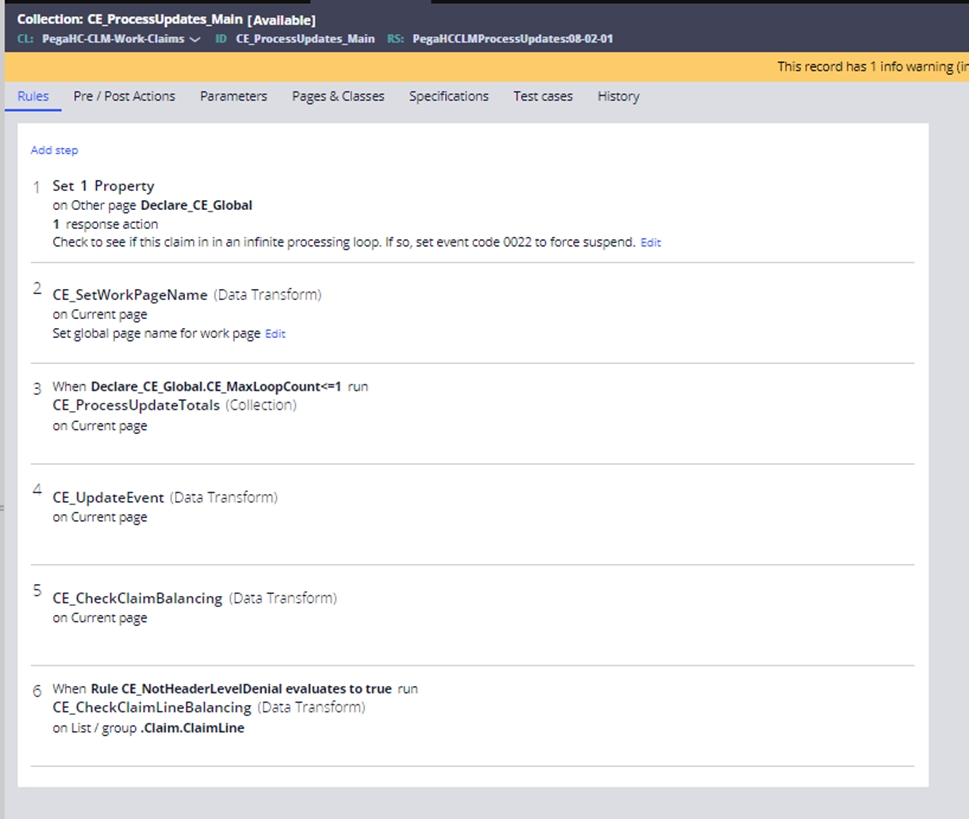Claims finalization
Introduction
The claims finalization routines set the final status on the claim and approve it for payment. These routines are responsible for a variety of tasks, including:
- Reviewing the events that are set on the claim to prioritize and set the appropriate line or claim status
- Performing any final claim-level pricing deductions
- Balancing the claim at the line and claim level
- Setting any final claim adjustments
- Setting the work object status and the status at the line and claim
The finalization routines are in the final three steps of the adjudication orchestration shown below.

- The first step is to finalize a claim is event review module.
The Event review module is responsible for sorting any open event codes. Event codes are sorted in the following order: Deny, Suspend, and Informational. If there are multiple suspend codes, these are sorted by their priority. The CE_ProcessOpenEventCodes collection is responsible for performing the sort.

If event codes are set to suspend, they are then sent to the CE_Suspend process, which determines whether the suspend process configured on the claim is set for recycle or route to a workbasket for review.
The random audits are executed in this flow if they have not been previously run and if there are no open event codes on the claim.
If there are no open event codes on the claim or the event codes are for deny or informational, the process is complete.
- After processing the open event codes, the next step is to process updates.
The process updates the CE_ProcessUpdates collection, shown below. It is responsible for updating the totals on the claim, updating any event codes, and checking the claim for balancing at the claim and line level. Finally, the messaging for exhausted accumulators is created.

The process update totals collection is responsible for summing the payment information at the line so that it is ready for header-level processing. Once that is complete, if the claim needs to perform any header-level calculations from COB or Medicaid Reclamation processing, those are performed.
The update event code process is responsible for setting the first pass indicator. It looks to see if any event codes are still open and sets the processing time for the claims.
The check claim balancing routines validate that the claim has been balanced successfully. Header claim balancing routines use the following calculation:
Approved Amount = Claim Total Charge – (Sum of Adjustments at Claim Level + Sum of All Adjustments at Claim Line Level).
Line Claim Balancing routines use the following calculation:
Approved Amount = Line Charge Amount – Sum of Adjustments at the Claim Line Level.
Approved Unit = Line Charged Units – Sum of Adjustment Units at the Claim Live Level.
If either the header or lines fail to balance, then the balancing event codes (8501 and 8502) are set.
If Units at the Line Level are not balanced, balancing event code 8503 is set.
The CheckExhaustedAccums process checks if there are accumulators that were exhausted in the processing. If necessary, it creates items to route to a workbasket for review.
If any event codes are opened during this step in the flow, the claim is routed back to event review to make sure that they can be resolved appropriately.
- The final step in the Finalization Routines is the CE_FinalizeClaim
collection:
In this collection, CE_FinalizeClaim, denied claims are updated appropriately, the claim and work object is updated, the subscriber lock is removed, and the updates for accumulators and authorizations are applied. When external systems need to be updated with finalized claim information, the CE_ProcessUpdatesFinalize collection is appended with the update call.

The final processing for the action codes checks to see if an action code requires the creation of a new work object to track the business ruleset by the action code.
Previous topic COB payer edits Next topic Late Payment Interest
